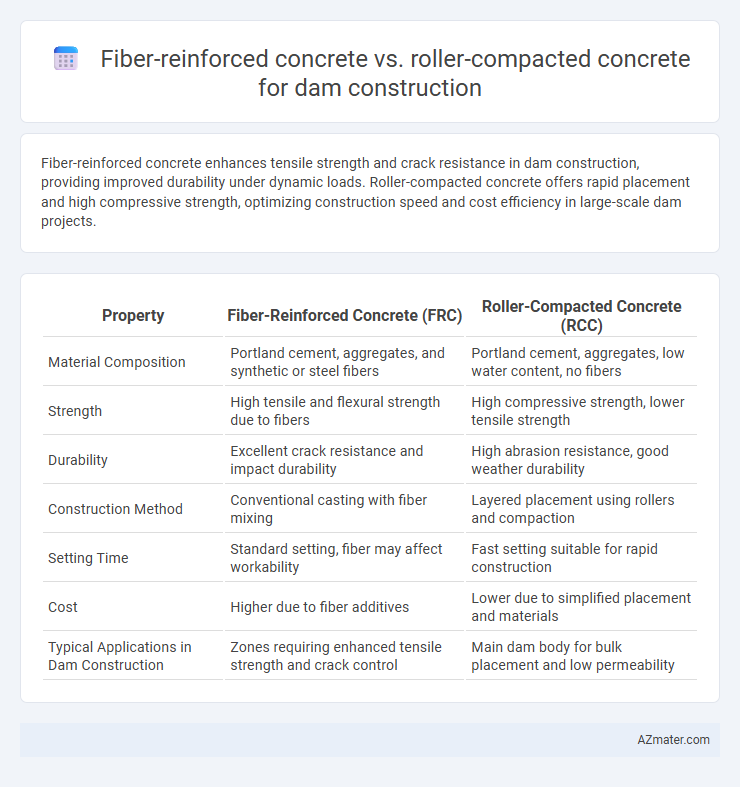Fiber-reinforced concrete enhances tensile strength and crack resistance in dam construction, providing improved durability under dynamic loads. Roller-compacted concrete offers rapid placement and high compressive strength, optimizing construction speed and cost efficiency in large-scale dam projects.
Table of Comparison
| Property | Fiber-Reinforced Concrete (FRC) | Roller-Compacted Concrete (RCC) |
|---|---|---|
| Material Composition | Portland cement, aggregates, and synthetic or steel fibers | Portland cement, aggregates, low water content, no fibers |
| Strength | High tensile and flexural strength due to fibers | High compressive strength, lower tensile strength |
| Durability | Excellent crack resistance and impact durability | High abrasion resistance, good weather durability |
| Construction Method | Conventional casting with fiber mixing | Layered placement using rollers and compaction |
| Setting Time | Standard setting, fiber may affect workability | Fast setting suitable for rapid construction |
| Cost | Higher due to fiber additives | Lower due to simplified placement and materials |
| Typical Applications in Dam Construction | Zones requiring enhanced tensile strength and crack control | Main dam body for bulk placement and low permeability |
Introduction to Dam Construction Materials
Fiber-reinforced concrete enhances tensile strength, crack resistance, and durability by incorporating synthetic or steel fibers, making it suitable for high-stress zones in dam construction. Roller-compacted concrete (RCC) offers rapid placement, reduced cement content, and lower cost, ideal for large-volume dam structures requiring fast construction with sufficient compressive strength. Selecting between fiber-reinforced concrete and RCC depends on project-specific demands such as load-bearing capacity, abrasion resistance, and construction speed.
Overview of Fiber-Reinforced Concrete (FRC)
Fiber-Reinforced Concrete (FRC) incorporates synthetic or steel fibers to enhance tensile strength, flexibility, and crack resistance, making it suitable for dam construction where durability and structural integrity are critical. The dispersed fibers improve impact resistance and reduce shrinkage cracking, which contributes to the long-term stability of dam structures under dynamic loading conditions. FRC's enhanced mechanical properties and durability compared to conventional concrete make it an efficient choice for dam spillways and slabs subject to high-stress environments.
Overview of Roller-Compacted Concrete (RCC)
Roller-Compacted Concrete (RCC) is a highly durable, dry-mix concrete that is compacted using heavy rollers, providing exceptional strength and rapid construction capabilities ideal for large-scale dam projects. RCC's low slump and zero-slump mixes enable efficient layering without formwork, reducing material costs and construction time compared to traditional concrete types used in dam construction. Its ability to achieve high compressive strength and resist permeability enhances dam safety and longevity, making it a preferred choice over fiber-reinforced concrete in many dam applications.
Structural Performance Comparison
Fiber-reinforced concrete (FRC) enhances ductility and crack resistance in dam construction by distributing tensile stresses through embedded fibers, improving tensile strength and impact resistance. Roller-compacted concrete (RCC) provides high compressive strength and rapid placement due to its low water content and compacted layers, favoring large-scale dam projects with reduced construction time. Structurally, FRC excels in energy absorption and crack control, while RCC offers superior stiffness and durability under heavy loads; selecting between them depends on specific dam design requirements and environmental conditions.
Durability and Longevity
Fiber-reinforced concrete enhances durability in dam construction through improved crack resistance and reduced permeability, extending structural lifespan under fluctuating stresses. Roller-compacted concrete offers superior longevity by delivering high-density placement and low shrinkage, which enhances resistance to abrasion and freeze-thaw cycles. Both materials optimize dam resilience, yet fiber reinforcement specifically targets tensile strength while roller-compacted concrete ensures long-term stability in large-scale applications.
Construction Efficiency and Methods
Fiber-reinforced concrete enhances construction efficiency in dam construction by improving tensile strength and crack resistance, allowing for thinner sections and reduced curing times. Roller-compacted concrete (RCC) offers rapid placement and compaction through heavy rollers, enabling faster layer-by-layer construction with minimal formwork. The choice between fiber-reinforced concrete and RCC depends on project scale and site conditions, but RCC typically excels in large-volume, high-speed dam projects due to mechanized methods.
Cost Analysis and Budget Considerations
Fiber-reinforced concrete typically incurs higher initial material costs due to the inclusion of synthetic or steel fibers, but it offers enhanced durability and reduced maintenance expenses over the dam's lifecycle. Roller-compacted concrete (RCC) presents a cost-effective alternative with faster placement rates and lower labor costs, making it suitable for large-scale dam construction projects with strict budget constraints. Evaluating the total cost of ownership, including long-term performance and repair frequency, is crucial for selecting the optimal concrete type aligned with the dam's structural and financial requirements.
Environmental Impact and Sustainability
Fiber-reinforced concrete (FRC) reduces the need for traditional steel reinforcement, lowering carbon emissions and enhancing durability for dam construction, which extends the service life and reduces maintenance-related environmental impact. Roller-compacted concrete (RCC) utilizes a dry mix with lower cement content and allows rapid placement, minimizing energy consumption and site disturbance, thereby promoting sustainability in large-scale dam projects. Both materials contribute to sustainable dam construction, with FRC offering improved structural resilience and RCC providing efficient resource use and reduced carbon footprint.
Case Studies and Real-World Applications
Fiber-reinforced concrete (FRC) enhances tensile strength and crack resistance, demonstrated in the Hoover Dam Bypass project where fiber integration improved durability under dynamic loads. Roller-compacted concrete (RCC) offers rapid placement and cost-efficiency, evidenced by the Upper Stillwater Dam in Montana, where RCC enabled faster construction with high compressive strength and reduced cement usage. Comparative studies reveal FRC's superior fracture toughness suits seismic zones, while RCC's ease of placement excels in large-scale dam projects requiring swift construction timelines.
Conclusion: Choosing the Optimal Concrete for Dams
Fiber-reinforced concrete offers enhanced tensile strength and crack resistance, making it suitable for areas of dams exposed to dynamic stresses and potential seismic activity. Roller-compacted concrete provides rapid placement and high compressive strength, ideal for large-scale dam foundations requiring efficient construction and durability under heavy loads. Selecting the optimal concrete depends on project-specific needs, with fiber reinforcement favored for structural resilience and roller-compacted concrete preferred for economic efficiency and robust foundational performance.

Infographic: Fiber-reinforced concrete vs Roller-compacted concrete for Dam construction
 azmater.com
azmater.com